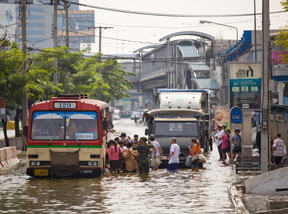According to a study by the World Bank and OECD, climate change, rapid urbanization and subsiding land are putting the world’s coastal cities at increasing risk of dangerous and costly flooding. The study, “Future flood losses in major coastal cities”, found that the average global flood losses could rise from 6 billion dollars in 2005 to 1 trillion dollars per year in 2050 if cities don’t take steps to adapt. At particular risk are coastal megacities in Southeast Asia and the eastern United States.
In its Revision of the World Urbanization Prospect, which is published every two years, the UN (2011) revealed that a total of approximately 890 million city residents are currently exposed to natural disasters.
Axel Theis, Board Member of Allianz SE, explains that a completely new risk landscape has developed for the insurance industry : “The frequency and intensity of climatological events has increased on a global scale over the last 50 years – and with it the concentration of insured assets. At the same time infrastructure expansion cannot keep pace with the increasing needs of the population. This imbalance makes cities extremely vulnerable to natural disasters, especially in Asia.”
Asia to be hardest hit
Already today, cities like Beijing, Delhi, Jakarta, Manila, Mumbai, Shanghai and Taipei are all at risk from flooding and/or typhoons. In comparison to the United States, Asia is 62 times more vulnerable to flooding and 40 times more vulnerable to tropical cyclones.
Asia stands to lose much more in natural disasters. At the same time, there is still a serious insurance protection gap for natural catastrophe risks. Catastrophes such as the flood in Bangkok in 2011 costing 45 billion dollars demonstrate the accumulation of risks is rising exponentially with ‘hidden risks’ such as contingent business interruption increasingly prevalent.
Climate change is set to further exacerbate the situation in Asia. Unless managed appropriately – for example, through such measures as insurance solutions as well as adaptation and mitigation strategies – the potential extent of damage and the repercussions on the population would therefore be significant in Asia’s urban centers.
Increasing risk exposure
And while insurance density continues to grow thanks to greater prosperity, so do the uncertainties in the insurance industry due to paucity of risk assessment data.
“In order to keep up with the rapid changes in risk concentration, we’re using the most modern technology and models,” says Theis. “For instance, by utilizing satellite technology and 3D imaging, we can assess risks precisely – down to the level of individual buildings. But the most sophisticated mathematical model in the world can only work if the data used is correct and the risk is clearly identifiable.”
Theis continues, “The Thailand flood was a mega-occurrence of this kind that couldn’t be modeled beforehand. Many company premises were submerged, which led to supply chain interruptions across the world. To be able to even better assess risks in the future, technological advances such as geocoding but also an ongoing direct dialogue with the customer are fundamental”
